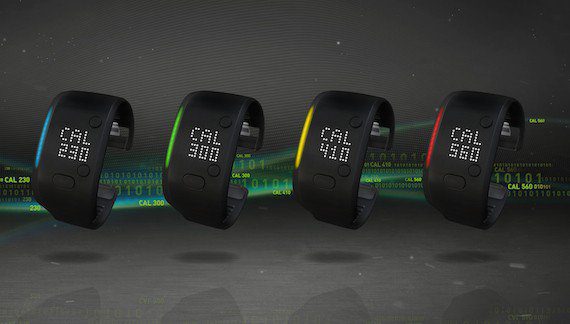The Adidas miCoach Fit Smart burst out of the German sports giant’s lab back in 2014, hot on the heels of the Adidas miCoach Smart Run.
Whereas the Fit Smart’s older brother packed in GPS connectivity, the new arrival shunned this feature in order to slim-down and offer a better battery performance.
When we reviewed the Fit Smart just over a year ago we lamented, “It’s neither a specialist GPS running watch nor an everyday activity tracker – it lies somewhere in between and, as a result, it falls short of being a device that we’d highly recommend.”
But now, thanks to an update that brings step tracking, calorie counting and estimated distance measuring to the workout-assistant, it is an everyday tracker – hence the updated review.
Read on to find out how it fares…
Adidas Fit Smart: Design and build
Although not as well received as Adidas would have wanted, we at Wareable were quite enamoured with the original miCoach training smartwatch, the Smart Run, and were excited to hear that a follow up device was about to hit the shops.
Whereas the Smart Run was quite a chunky device, with a large strap and oversized face, the miCoach Fit Smart pays its dues, design-wise, to the ever-growing fitness tracker genre that’s dominating wearable tech right now.

It hasn’t completely dumped the idea of a display – although there’s no glass or pixels packed into the Fit Smart – instead you’re looking at a 34mm silicone strap that hides a 17 x 11 LED matrix display. Alongside this basic yet effective display are a row of neon LED strip-lights, which we’ll come back to later, and two physical navigation buttons. There’s also a main action button below the display.
The silicone strap lets your skin breathe quite effectively and the clasp sits pretty comfortably on the underside of the wrist. At 50g it’s hardly going to weigh your arm down either.
The Fit Smart comes in two colours: black and pearl. It’s the latter colour variant that we took for a test run and, although it looks pretty futuristic when the plethora of LEDs are lit up, it is susceptible to looking a little bit grubby after a few training sessions. The black one shouldn’t suffer from this issue, obviously.
It’s sweat proof and is 3ATM water resistant, although Adidas recommends not swimming with it on.
Adidas miCoach Fit Smart: Training
On the underside of that LED display you’ll find the Mio heart-sensor, which we’re told is the same one that was present on the Smart Run GPS running watch and the same one you’d find onboard Mio fitness wearables.
Your heart rate plays a key role in the Fit Smart experience, which is centred around helping you train in specific zones. It’s important to remember that the miCoach Fit Smart isn’t a dedicated running watch – rather a training companion that is designed to work across a range of activities including strength and flex regimes.
During a training session, the colour strip of LED lights light up to tell you what zone you’re in, with five different colours on show – all representing a different training intensity zone. During a free training session it’s up to the user to monitor his or her own zones and adapt accordingly, while during a set training session, the LED display will tell you to increase or decrease intensity in order to hit the desired level. You’ll also feel vibration alerts as well when you need to step it up or ease it off.
It’s a system that works well and the display’s instructions are pretty clear. However, you’re putting a lot of trust into the heart rate monitor’s accuracy and we’re not entirely convinced of its pulse recording skills. When testing the Fit Smart against the TomTom Cardio and the old miCoach Fit Smart, we found that our levels varied greatly across the devices, with the Fit Smart and the TomTom being much more in-tune with each other.
Getting a heart rate to register isn’t exactly a speedy affair either – you’ll be waiting around for around a minute before it locks in.
Adidas miCoach Fit Smart: Activity tracking
The biggest criticism we threw at the Fit Smart originally was its lack of fitness tracking smarts; it seemed pointless to have an activity band that didn’t offer basic lifestyle recording.
That’s been fixed, thankfully with the Fit Smart now using its sensors and accelerometer to count steps and estimate distances travelled and calories burned.
You can view your progress in detail on the app – it also tallies with distances covered on other Adidas products synced to you account – or directly on the device itself by tapping the main button.
We found step counting to be a little generous compared to a Jawbone UP3 but, as with all algorithmically created counts, the stats should be used as a guide and not an exact science.
The revamped Train & Run app allow lets you set daily and weekly goals.
Adidas miCoach Fit Smart: Ecosystem
Like the Smart Run, the Fit Smart is heavily tied into the Adidas miCoach ecosystem, which is both desktop and app based.
With the Fit Smart you’ll be using the app (iOS, Android and Windows Phone), which we’re glad to say has had a major spruce-up in time for the new activity tracking update.
Once paired using Bluetooth 4.0, the Fit Smart will keep in sync with the app, sending over details of your latest training sessions and receiving the details of any set workouts that you want to do – you can store 15 different workouts, each with their own intensity zone objectives, directly onto the band. These workouts can customised yourself within the app, or you can select one of the many on offer from Adidas.

Within the app you can also customise the Fit Smart’s display, opting for a single screen showing a specific training aspect (distance travelled, calories burned, heart rate, pace and so on) or a split screen with two dynamics on display.
You can train with the Fit Smart untethered from a smartphone; it works independently. However, with no GPS connectivity built in, the Fit Smart is extremely unreliable when it comes to tracking distances.
There is a 12 minute calibration workout built in to the Fit Smart that you should carry out in order to improve speed and distance recordings, although we found that this made only a minimal difference. Long story short: if you want detailed data on your run you’re going to need to tether to your smartphone and the miCoach app, making use of your mobile’s GPS connectivity.
The device itself has memory enough to store around 10 hours of workout data. You can access your recent history by navigating through the watch’s homescreen.
This homescreen extends to one that displays the time and two that start a new workout. The latter splits into free training and your stored workouts, which are clearly labelled.
Adidas Fit Smart: Extras and battery life
The Adidas miCoach Fit Smart smashes its older brother out of the park when it comes to battery life.
Adidas states that you’ll get five days of use from the 200mAh battery, with an hour’s training a day. We’ve done six 5km runs with our Fit Smart in free training mode, as well as testing out a couple of the set workouts and we’ve still not had to give it a charge. It’s been on standby mode for over a week as well.
It will charge from flat in three hours but the bad news is, like most new wearables on the market – it does need its own charging cradle. This isn’t a moan that’s unique to Adidas though, so we’ll not mark it down for that.
Source : http://www.wareable.com/fitness-trackers/adidas-micoach-fit-smart-review



















Facebook Comments